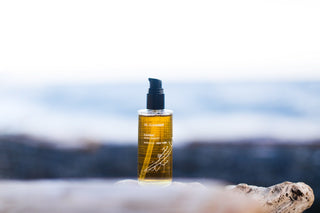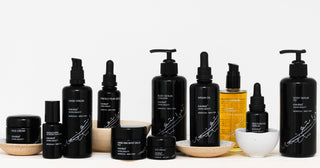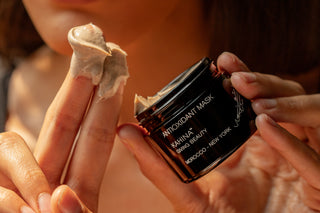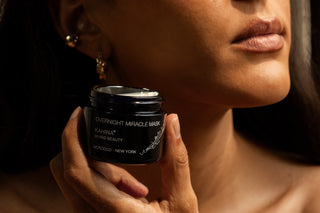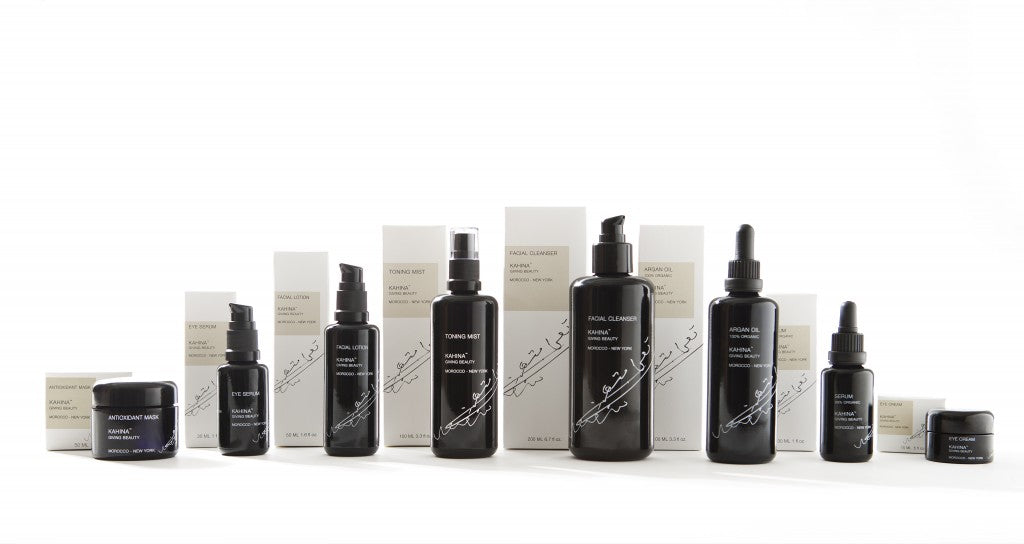 In case you're just joining us now, we've been going over some common issues that people have when converting to a green beauty routine. Part one addressed clogged pores and acne, while part two addressed persistent dryness. Here, we'll take on sensitivity, or a perceived increase in sensitivity, that some people report as they begin experimenting with green beauty products. Read on if you've had problems with sensitivity and if you've already been evaluated by a physician (dermatologist, primary care and/or allergist) who has not discovered allergies or underlying medical reasons for your sensitivity.
The problem: As I'm converting to green beauty, I'm noticing more redness, irritation, or general sensitivity. I'm tempted to go back to my trusty Cetaphil products, which, though full of synthetic ingredients, never irritated my skin.
To consider: A big fat myth surrounding green beauty is that it is inherently more gentle than it's less-natural counterparts. The thinking goes something like, "Well, I've ditched the harsh chemicals my body doesn't recognize, so automatically my skin will be calmer." Not necessarily so. An irritant is an irritant is an irritant, whether created in a test tube or sprung from the earth. Opponents of green beauty love to bring up poison ivy as an example of something found in nature, 100% natural, that is highly irritating. They also relish reminding us that everything, even water, is a chemical ("beware of dihydrogen monoxide!" is a common sarcastic refrain). If those two battle cries help get the point across, fine. But why is it so easy to conflate irritation with synthetic chemicals? Maybe because as an everyday skincare consumer it's pretty easy to overdo it with the acids and peels and retinoids and benzoyl peroxide, most of which are found in conventional, non-organic/natural formulations. Regardless, there are sensitivities that extend into the organic/natural realm. Unfortunately, uncovering and positively identifying these sensitivities can take time, patience, and very, very careful observation.
The plan:
As mentioned in part one, be very careful about how you sample and test out new products. Pick a gentle, simple lineup of products and stick to them for three months minimum before adding more products in. We like Kahina Facial Cleanser - Kahina Toning Mist - Kahina Argan Oil as your morning and evening routine, adding in Kahina Facial Lotion if you have dryer skin.
If you are concerned about sensitive skin, the fewer the ingredients, the better. There's a reason we consistently recommend Kahina Argan Oil to those with finicky skin: it's a single, organic ingredient. The more ingredients in a formulation, the greater the likelihood that it contains a potential irritant and the harder time you will have identifying which ingredient that is.
Do not over-exfoliate or over-stimulate. In parts one and two, we went over how important exfoliation is to healthy skin. That said, you have to choose the most gentle option that your skin will tolerate. If a facial brush like a Clarisonic leaves you red or raw feeling, it is not a good fit. Similarly, face masks with "warming" ingredients or very drawing (and drying) clay can wreak havoc.
Watch your treatment products. Vitamin C, retinoids, acids, apple cider vinegar, tea tree oil, etc. - these can be great, effective skincare ingredients but they are particularly active and when you overuse or misuse them, you are setting yourself up for sensitivity. Different people have different tolerance levels for these products, so when in doubt, go cautiously, and use one at a time for a month before adding in a new one.
Keep an eye on your makeup, oral care and haircare products, too. If you've made changes in these product categories at the same time as your skincare switch up, they're also potential candidates for new irritation. We'd argue that these are very uncommon reasons for sensitivity but worth a mention nonetheless. Problematic hair care products will typically produce irritation on your neck, your back, or around your hairline. Toothpaste sensitivities show up as irritation around the mouth. Problematic makeup will produce irritation wherever you applied it. If you suspect irritation is stemming from one of these sources, stop using it for at least a week, ideally a month, and see if conditions improve.
Choose skincare products with ingredients shown to soothe skin; favorites found in many Kahina products include aloe vera, bisabolol, green/white tea, rosewater, calendula, resveratrol, willow bark, chamomile, blue tansy, and of course argan oil.
Go back to the beginning. By that we mean, pare it down! It is so, so easy to accumulate lotions and potions in your quest for the perfect routine. It is also easy to want to try to incorporate all of them into your regimen, since, you know, you have them in your cabinet and don't want to waste them. If you're using 10 different skincare products and it's working for you, amazing! But if it's not, go on an elimination diet and scale way back. Like three products max. Twice a day. For a month. Your skin could just need a reset.
A word on essential oils: essential oils are typically very healing and skin-positive; in addition, they are typically in very low concentrations which minimizes irritation potential. However, essential oils are also actives and therefore a few of them can be a problem for some people. If you are having an issue with extreme sensitivity, avoid formulations with essential oils for a while (often labeled as "unscented") and see how your skin does. Does it rebound and become more resilient? Or is there no change? For sensitive skin types seeking to avoid scent or essential oils, our top recommendations include Kahina Argan Oil, Kahina Facial Lotion, and Kahina Eye Serum.
We hope this three-part series was informative and helpful to you as you continue exploring organic & natural options in skincare. Oftentimes, being aware of potential pitfalls in your routine, correcting them, and then giving time for your skin to re-balance itself (this takes minimum 1 month!) will help get you through any bumps on the green beauty journey.
In case you're just joining us now, we've been going over some common issues that people have when converting to a green beauty routine. Part one addressed clogged pores and acne, while part two addressed persistent dryness. Here, we'll take on sensitivity, or a perceived increase in sensitivity, that some people report as they begin experimenting with green beauty products. Read on if you've had problems with sensitivity and if you've already been evaluated by a physician (dermatologist, primary care and/or allergist) who has not discovered allergies or underlying medical reasons for your sensitivity.
The problem: As I'm converting to green beauty, I'm noticing more redness, irritation, or general sensitivity. I'm tempted to go back to my trusty Cetaphil products, which, though full of synthetic ingredients, never irritated my skin.
To consider: A big fat myth surrounding green beauty is that it is inherently more gentle than it's less-natural counterparts. The thinking goes something like, "Well, I've ditched the harsh chemicals my body doesn't recognize, so automatically my skin will be calmer." Not necessarily so. An irritant is an irritant is an irritant, whether created in a test tube or sprung from the earth. Opponents of green beauty love to bring up poison ivy as an example of something found in nature, 100% natural, that is highly irritating. They also relish reminding us that everything, even water, is a chemical ("beware of dihydrogen monoxide!" is a common sarcastic refrain). If those two battle cries help get the point across, fine. But why is it so easy to conflate irritation with synthetic chemicals? Maybe because as an everyday skincare consumer it's pretty easy to overdo it with the acids and peels and retinoids and benzoyl peroxide, most of which are found in conventional, non-organic/natural formulations. Regardless, there are sensitivities that extend into the organic/natural realm. Unfortunately, uncovering and positively identifying these sensitivities can take time, patience, and very, very careful observation.
The plan:
As mentioned in part one, be very careful about how you sample and test out new products. Pick a gentle, simple lineup of products and stick to them for three months minimum before adding more products in. We like Kahina Facial Cleanser - Kahina Toning Mist - Kahina Argan Oil as your morning and evening routine, adding in Kahina Facial Lotion if you have dryer skin.
If you are concerned about sensitive skin, the fewer the ingredients, the better. There's a reason we consistently recommend Kahina Argan Oil to those with finicky skin: it's a single, organic ingredient. The more ingredients in a formulation, the greater the likelihood that it contains a potential irritant and the harder time you will have identifying which ingredient that is.
Do not over-exfoliate or over-stimulate. In parts one and two, we went over how important exfoliation is to healthy skin. That said, you have to choose the most gentle option that your skin will tolerate. If a facial brush like a Clarisonic leaves you red or raw feeling, it is not a good fit. Similarly, face masks with "warming" ingredients or very drawing (and drying) clay can wreak havoc.
Watch your treatment products. Vitamin C, retinoids, acids, apple cider vinegar, tea tree oil, etc. - these can be great, effective skincare ingredients but they are particularly active and when you overuse or misuse them, you are setting yourself up for sensitivity. Different people have different tolerance levels for these products, so when in doubt, go cautiously, and use one at a time for a month before adding in a new one.
Keep an eye on your makeup, oral care and haircare products, too. If you've made changes in these product categories at the same time as your skincare switch up, they're also potential candidates for new irritation. We'd argue that these are very uncommon reasons for sensitivity but worth a mention nonetheless. Problematic hair care products will typically produce irritation on your neck, your back, or around your hairline. Toothpaste sensitivities show up as irritation around the mouth. Problematic makeup will produce irritation wherever you applied it. If you suspect irritation is stemming from one of these sources, stop using it for at least a week, ideally a month, and see if conditions improve.
Choose skincare products with ingredients shown to soothe skin; favorites found in many Kahina products include aloe vera, bisabolol, green/white tea, rosewater, calendula, resveratrol, willow bark, chamomile, blue tansy, and of course argan oil.
Go back to the beginning. By that we mean, pare it down! It is so, so easy to accumulate lotions and potions in your quest for the perfect routine. It is also easy to want to try to incorporate all of them into your regimen, since, you know, you have them in your cabinet and don't want to waste them. If you're using 10 different skincare products and it's working for you, amazing! But if it's not, go on an elimination diet and scale way back. Like three products max. Twice a day. For a month. Your skin could just need a reset.
A word on essential oils: essential oils are typically very healing and skin-positive; in addition, they are typically in very low concentrations which minimizes irritation potential. However, essential oils are also actives and therefore a few of them can be a problem for some people. If you are having an issue with extreme sensitivity, avoid formulations with essential oils for a while (often labeled as "unscented") and see how your skin does. Does it rebound and become more resilient? Or is there no change? For sensitive skin types seeking to avoid scent or essential oils, our top recommendations include Kahina Argan Oil, Kahina Facial Lotion, and Kahina Eye Serum.
We hope this three-part series was informative and helpful to you as you continue exploring organic & natural options in skincare. Oftentimes, being aware of potential pitfalls in your routine, correcting them, and then giving time for your skin to re-balance itself (this takes minimum 1 month!) will help get you through any bumps on the green beauty journey.
 In case you're just joining us now, we've been going over some common issues that people have when converting to a green beauty routine. Part one addressed clogged pores and acne, while part two addressed persistent dryness. Here, we'll take on sensitivity, or a perceived increase in sensitivity, that some people report as they begin experimenting with green beauty products. Read on if you've had problems with sensitivity and if you've already been evaluated by a physician (dermatologist, primary care and/or allergist) who has not discovered allergies or underlying medical reasons for your sensitivity.
The problem: As I'm converting to green beauty, I'm noticing more redness, irritation, or general sensitivity. I'm tempted to go back to my trusty Cetaphil products, which, though full of synthetic ingredients, never irritated my skin.
To consider: A big fat myth surrounding green beauty is that it is inherently more gentle than it's less-natural counterparts. The thinking goes something like, "Well, I've ditched the harsh chemicals my body doesn't recognize, so automatically my skin will be calmer." Not necessarily so. An irritant is an irritant is an irritant, whether created in a test tube or sprung from the earth. Opponents of green beauty love to bring up poison ivy as an example of something found in nature, 100% natural, that is highly irritating. They also relish reminding us that everything, even water, is a chemical ("beware of dihydrogen monoxide!" is a common sarcastic refrain). If those two battle cries help get the point across, fine. But why is it so easy to conflate irritation with synthetic chemicals? Maybe because as an everyday skincare consumer it's pretty easy to overdo it with the acids and peels and retinoids and benzoyl peroxide, most of which are found in conventional, non-organic/natural formulations. Regardless, there are sensitivities that extend into the organic/natural realm. Unfortunately, uncovering and positively identifying these sensitivities can take time, patience, and very, very careful observation.
The plan:
As mentioned in part one, be very careful about how you sample and test out new products. Pick a gentle, simple lineup of products and stick to them for three months minimum before adding more products in. We like Kahina Facial Cleanser - Kahina Toning Mist - Kahina Argan Oil as your morning and evening routine, adding in Kahina Facial Lotion if you have dryer skin.
If you are concerned about sensitive skin, the fewer the ingredients, the better. There's a reason we consistently recommend Kahina Argan Oil to those with finicky skin: it's a single, organic ingredient. The more ingredients in a formulation, the greater the likelihood that it contains a potential irritant and the harder time you will have identifying which ingredient that is.
Do not over-exfoliate or over-stimulate. In parts one and two, we went over how important exfoliation is to healthy skin. That said, you have to choose the most gentle option that your skin will tolerate. If a facial brush like a Clarisonic leaves you red or raw feeling, it is not a good fit. Similarly, face masks with "warming" ingredients or very drawing (and drying) clay can wreak havoc.
Watch your treatment products. Vitamin C, retinoids, acids, apple cider vinegar, tea tree oil, etc. - these can be great, effective skincare ingredients but they are particularly active and when you overuse or misuse them, you are setting yourself up for sensitivity. Different people have different tolerance levels for these products, so when in doubt, go cautiously, and use one at a time for a month before adding in a new one.
Keep an eye on your makeup, oral care and haircare products, too. If you've made changes in these product categories at the same time as your skincare switch up, they're also potential candidates for new irritation. We'd argue that these are very uncommon reasons for sensitivity but worth a mention nonetheless. Problematic hair care products will typically produce irritation on your neck, your back, or around your hairline. Toothpaste sensitivities show up as irritation around the mouth. Problematic makeup will produce irritation wherever you applied it. If you suspect irritation is stemming from one of these sources, stop using it for at least a week, ideally a month, and see if conditions improve.
Choose skincare products with ingredients shown to soothe skin; favorites found in many Kahina products include aloe vera, bisabolol, green/white tea, rosewater, calendula, resveratrol, willow bark, chamomile, blue tansy, and of course argan oil.
Go back to the beginning. By that we mean, pare it down! It is so, so easy to accumulate lotions and potions in your quest for the perfect routine. It is also easy to want to try to incorporate all of them into your regimen, since, you know, you have them in your cabinet and don't want to waste them. If you're using 10 different skincare products and it's working for you, amazing! But if it's not, go on an elimination diet and scale way back. Like three products max. Twice a day. For a month. Your skin could just need a reset.
A word on essential oils: essential oils are typically very healing and skin-positive; in addition, they are typically in very low concentrations which minimizes irritation potential. However, essential oils are also actives and therefore a few of them can be a problem for some people. If you are having an issue with extreme sensitivity, avoid formulations with essential oils for a while (often labeled as "unscented") and see how your skin does. Does it rebound and become more resilient? Or is there no change? For sensitive skin types seeking to avoid scent or essential oils, our top recommendations include Kahina Argan Oil, Kahina Facial Lotion, and Kahina Eye Serum.
We hope this three-part series was informative and helpful to you as you continue exploring organic & natural options in skincare. Oftentimes, being aware of potential pitfalls in your routine, correcting them, and then giving time for your skin to re-balance itself (this takes minimum 1 month!) will help get you through any bumps on the green beauty journey.
In case you're just joining us now, we've been going over some common issues that people have when converting to a green beauty routine. Part one addressed clogged pores and acne, while part two addressed persistent dryness. Here, we'll take on sensitivity, or a perceived increase in sensitivity, that some people report as they begin experimenting with green beauty products. Read on if you've had problems with sensitivity and if you've already been evaluated by a physician (dermatologist, primary care and/or allergist) who has not discovered allergies or underlying medical reasons for your sensitivity.
The problem: As I'm converting to green beauty, I'm noticing more redness, irritation, or general sensitivity. I'm tempted to go back to my trusty Cetaphil products, which, though full of synthetic ingredients, never irritated my skin.
To consider: A big fat myth surrounding green beauty is that it is inherently more gentle than it's less-natural counterparts. The thinking goes something like, "Well, I've ditched the harsh chemicals my body doesn't recognize, so automatically my skin will be calmer." Not necessarily so. An irritant is an irritant is an irritant, whether created in a test tube or sprung from the earth. Opponents of green beauty love to bring up poison ivy as an example of something found in nature, 100% natural, that is highly irritating. They also relish reminding us that everything, even water, is a chemical ("beware of dihydrogen monoxide!" is a common sarcastic refrain). If those two battle cries help get the point across, fine. But why is it so easy to conflate irritation with synthetic chemicals? Maybe because as an everyday skincare consumer it's pretty easy to overdo it with the acids and peels and retinoids and benzoyl peroxide, most of which are found in conventional, non-organic/natural formulations. Regardless, there are sensitivities that extend into the organic/natural realm. Unfortunately, uncovering and positively identifying these sensitivities can take time, patience, and very, very careful observation.
The plan:
As mentioned in part one, be very careful about how you sample and test out new products. Pick a gentle, simple lineup of products and stick to them for three months minimum before adding more products in. We like Kahina Facial Cleanser - Kahina Toning Mist - Kahina Argan Oil as your morning and evening routine, adding in Kahina Facial Lotion if you have dryer skin.
If you are concerned about sensitive skin, the fewer the ingredients, the better. There's a reason we consistently recommend Kahina Argan Oil to those with finicky skin: it's a single, organic ingredient. The more ingredients in a formulation, the greater the likelihood that it contains a potential irritant and the harder time you will have identifying which ingredient that is.
Do not over-exfoliate or over-stimulate. In parts one and two, we went over how important exfoliation is to healthy skin. That said, you have to choose the most gentle option that your skin will tolerate. If a facial brush like a Clarisonic leaves you red or raw feeling, it is not a good fit. Similarly, face masks with "warming" ingredients or very drawing (and drying) clay can wreak havoc.
Watch your treatment products. Vitamin C, retinoids, acids, apple cider vinegar, tea tree oil, etc. - these can be great, effective skincare ingredients but they are particularly active and when you overuse or misuse them, you are setting yourself up for sensitivity. Different people have different tolerance levels for these products, so when in doubt, go cautiously, and use one at a time for a month before adding in a new one.
Keep an eye on your makeup, oral care and haircare products, too. If you've made changes in these product categories at the same time as your skincare switch up, they're also potential candidates for new irritation. We'd argue that these are very uncommon reasons for sensitivity but worth a mention nonetheless. Problematic hair care products will typically produce irritation on your neck, your back, or around your hairline. Toothpaste sensitivities show up as irritation around the mouth. Problematic makeup will produce irritation wherever you applied it. If you suspect irritation is stemming from one of these sources, stop using it for at least a week, ideally a month, and see if conditions improve.
Choose skincare products with ingredients shown to soothe skin; favorites found in many Kahina products include aloe vera, bisabolol, green/white tea, rosewater, calendula, resveratrol, willow bark, chamomile, blue tansy, and of course argan oil.
Go back to the beginning. By that we mean, pare it down! It is so, so easy to accumulate lotions and potions in your quest for the perfect routine. It is also easy to want to try to incorporate all of them into your regimen, since, you know, you have them in your cabinet and don't want to waste them. If you're using 10 different skincare products and it's working for you, amazing! But if it's not, go on an elimination diet and scale way back. Like three products max. Twice a day. For a month. Your skin could just need a reset.
A word on essential oils: essential oils are typically very healing and skin-positive; in addition, they are typically in very low concentrations which minimizes irritation potential. However, essential oils are also actives and therefore a few of them can be a problem for some people. If you are having an issue with extreme sensitivity, avoid formulations with essential oils for a while (often labeled as "unscented") and see how your skin does. Does it rebound and become more resilient? Or is there no change? For sensitive skin types seeking to avoid scent or essential oils, our top recommendations include Kahina Argan Oil, Kahina Facial Lotion, and Kahina Eye Serum.
We hope this three-part series was informative and helpful to you as you continue exploring organic & natural options in skincare. Oftentimes, being aware of potential pitfalls in your routine, correcting them, and then giving time for your skin to re-balance itself (this takes minimum 1 month!) will help get you through any bumps on the green beauty journey.

